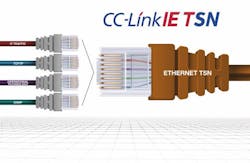Processing Q&A: Time-sensitive networking in industrial automation and converged networks
In this Processing Q&A, Tom Burke, global strategic advisor at CC Link Partner Association (CLPA), discusses time-sensitive networking (TSN) in industrial automation and converged networks.
Q: Can you provide an overview of TSN and explain how it can be used in process manufacturing industries?
TSN is a set of standards developed by the IEEE 802.1 working group to enhance Ethernet networks with deterministic, low-latency and high-reliability communication. It builds on standard Ethernet by adding features such as time synchronization and traffic scheduling, making it ideal for industrial applications where precise timing and reliability are critical.
In industrial networks, TSN ensures that data packets are delivered with guaranteed latency and minimal jitter, even in environments with heavy traffic. It achieves this through mechanisms such as Time-Aware Shapers (TAS), which prioritize time-critical data, and Precision Time Protocol (PTP) for clock synchronization across devices. This allows for real-time control and coordination between machines, sensors and controllers.
In process manufacturing industries — such as chemical, oil and gas, or food and beverage production — TSN can be a game-changer. These industries have many applications where synchronization is crucial to maintain product quality, safety and efficiency. TSN also delivers the ability to converge networks, enabling new and simplified network architectures.
Q: How does CC Link IE TSN differ from other TSN implementations?
CC-Link IE TSN, developed by the CC-Link Partner Association (CLPA) with significant backing from Mitsubishi Electric, is widely recognized as the first industrial network to integrate Time-Sensitive Networking (TSN) technology into an open Ethernet-based framework. Introduced in 2018, it combined the gigabit bandwidth of CC-Link IE (Industrial Ethernet) with TSN standards, marking a pioneering step in industrial automation.
TSN ensures precise time synchronization (via IEEE 802.1AS) and traffic scheduling (via IEEE 802.1Qbv), allowing real-time control data to coexist with non-critical traffic without interference. This was a groundbreaking move, as no other open industrial network had fully implemented TSN at that point.
While other industrial protocols have since adopted TSN features, CC-Link IE TSN’s claim as the "only" industrial TSN network often reflects its unique combination of features and its status as an open, fully realized solution at the time of its debut.
The "only" aspect can also be understood in terms of its comprehensive ecosystem and early market readiness. While other standards have are testing TSN variants today, CC-Link IE TSN was the first to deliver a fully specified, vendor-supported network with a broad range of compatible devices, setting a benchmark that others are still catching up to in terms of scope and adoption.
Q: Explain how this works for IT and OT network infrastructures.
An industrial network based on Ethernet with TSN integrates IT (Information Technology) and OT (Operational Technology) infrastructures by leveraging the strengths of standard Ethernet — universality, scalability and high bandwidth — while adding TSN’s deterministic, low-latency and reliable communication capabilities. This convergence enables a single network to handle both the data-driven needs of IT (e.g., cloud connectivity, analytics, device management, troubleshooting) and the real-time, mission-critical demands of OT (e.g., machine control, automation), which traditionally required separate systems.
Q: How can TSN enhance the performance of networks, edge computing and the IIoT? What does the expansive bandwidth capabilities provide?
TSN significantly enhances the performance of networks tied to machines and processes by delivering deterministic, low-latency and reliable communication over Ethernet. Its ability to synchronize devices with microsecond precision, prioritize critical traffic and ensure fault tolerance makes it a powerful upgrade for industrial automation. However, while TSN holds immense potential, its deployment is more likely to manifest as "real-time islands of communication" within specific, localized segments of a network rather than being broadly implemented across edge computers and Industrial Internet of Things (IIoT) infrastructures.
Q: Please share a common application of TSN and how this benefits the company implementing TSN.
This video from Keller, a leading provider of machines and consumables for industrial printing processes, showcases their advanced printing machine designed for industries such as automotive, cosmetics and consumer electronics. It highlights the machine’s modular system, capable of printing 3,000 units per hour with plans to reach 3,600, emphasizing its unique reconfigurability enabled by CC-Link IE TSN.
The printing process involves flame activation, multi-color printing with UV LED drying and hot stamping, all synchronized across three swappable modules.
Keller partnered with Mitsubishi Electric, leveraging their MELSEC MR-J5 servo drives and CC-Link IE TSN, to synchronize up to 128 servo drives with microsecond precision. This collaboration, ongoing since 2012, provided technical support and optimal components, enhancing productivity, flexibility and future scalability. The video underscores how TSN’s network convergence allows integration of additional vision sensors, positioning Keller as a European pioneer in adopting this technology for high-performance, customizable printing solutions.
Q: How does this impact sustainability and the environmental impact of manufacturing processes?
Ethernet with TSN enhances sustainability in manufacturing by driving energy efficiency, optimizing resources, supporting green tech, reducing physical infrastructure and lowering carbon emissions. Its real-time precision and network convergence enable smarter, leaner processes that align with environmental goals, making it a key enabler for eco-friendly industrial transformation. Over time, as adoption scales, TSN could significantly reduce the ecological footprint of manufacturing, particularly in energy-intensive sectors.
Q: What development support is available to develop CC Link IE TSN compatible products?
Beyond Mitsubishi, the CLPA boasts over 4,000 member companies and more than 3,000 compatible products as of 2024, reflecting a robust ecosystem. This collaborative approach, facilitated by the CLPA’s open standards and development tools (e.g., ASIC kits and software protocol stacks), ensures broad adoption and interoperability, reinforcing CC-Link IE TSN’s leadership.
